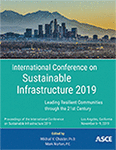International Conference on Sustainable Infrastructure 2019
The Impact of Climate Change on Urban Environment in GCC Countries and Related Energy Systems: Mitigation Measures and Associated Challenges
Publication: International Conference on Sustainable Infrastructure 2019: Leading Resilient Communities through the 21st Century
ABSTRACT
Emissions related to energy consumption in buildings could rapidly increase in the following decades, considering the high probability of increased outdoor temperatures and more frequent and prolonged heat waves. Countries with extreme climate, rapidly growing urban environment, and fossil fuel-based energy systems [for example, Gulf Cooperation Council (GCC) member states] would be most susceptible to such impacts. The main goal of this study is to evaluate the increase in building energy demand in GCC countries, driven by climate change, and assess the efficiency of suggested mitigation measures. Moreover, the potential obstacles for the implementation of such measures are examined from an interdisciplinary perspective. The results were obtained by simulating building energy performance for a representative residential building, under reference and forecasted weather conditions for all GCC member states. The findings indicate building energy demand increase of up to 16% and 28% in 2050 and 2080 (respectively). By implementing building envelope renovation as a mitigation measure, future energy demand could be reduced for up to 20%, achieving significant carbon emission savings. However, while such renovation measures proved to be economically and environmentally feasible in developed countries, additional investigation should be performed for GCC countries, taking into account local sociopolitical, environmental, and economic aspects.
Get full access to this chapter
View all available purchase options and get full access to this chapter.
REFERENCES
Abro, R. S. (1994). “Recognition of passive cooling techniques.” Renewable Energy, 5(5–8), 1143–1146.
Alaidroos, A., and Krarti, M. (2015). “Optimal design of residential building envelope systems in the Kingdom of Saudi Arabia.” Energy and Buildings, Elsevier B.V., 86, 104–117.
Ameer, B., and Krarti, M. (2016). “Impact of subsidization on high energy performance designs for Kuwaiti residential buildings.” Energy and Buildings, Elsevier B.V., 116, 249–262.
Andrić, I., Corre, O. Le, Lacarrière, B., Ferrão, P., and Al-, S. G. (2019). “Initial approximation of the implications for architecture due to climate change.” Advances in Building Energy Research, 1.
Andrić, I., Koc, M., and Al-Ghamdi, S. G. (2018). “A review of climate change implications for built environment: impacts, mitigation measures and associated challenges in developed and developing countries.” Journal of Cleaner Production, 211.
Andrić, I., Pina, A., Ferrão, P., Fournier, J., Lacarrière, B., and Le Corre, O. (2017a). “The impact of climate change on building heat demand in different climate types.” Energy and Buildings, 149, 225–234.
Andrić, I., Pina, A., Ferrão, P., Lacarriere, B., and Le Corre, O. (2017b). “The impact of renovation measures on building environmental performance : An emergy approach.” Journal of Cleaner Production, 162, 776–790.
Bayram, I. S., Saffouri, F., and Koc, M. (2018). “Generation, analysis, and applications of high resolution electricity load profiles in Qatar.” Journal of Cleaner Production, Elsevier Ltd, 183, 527–543.
Butera, F. M. (2010). “Climatic change and the built environment.” Advances in Building Energy Research, 4(1), 45–75.
Fawcett, T., Killip, G., and Janda, K. (2011). “Building Expertise : Identifying policy gaps and new ideas in housing eco-renovation in the UK and France.” ECEEE Summer Study Proceedings, 339–350.
Gupta, R., and Gregg, M. (2012). “Using UK climate change projections to adapt existing English homes for a warming climate.” Building and Environment, Elsevier Ltd, 55, 20–42.
IPCC. (2014). Climate Change 2014: Synthesis Report. Contribution of Working Groups I, II and III to the Fifth Assessment Report of the Intergovernmental Panel on Climate Change. Geneva, Switzerland.
Jafari, A., and Haghighi Poshtiri, A. (2017). “Passive solar cooling of single-storey buildings by an adsorption chiller system combined with a solar chimney.” Journal of Cleaner Production, Elsevier Ltd, 141, 662–682.
Jentsch, M. F., James, P. A. B., Bourikas, L., and Bahaj, A. S. (2013). “Transforming existing weather data for worldwide locations to enable energy and building performance simulation under future climates.” Renewable Energy, Elsevier Ltd, 55, 514–524.
Kharseh, M., and Al-Khawaja, M. (2016). “Retrofitting measures for reducing buildings cooling requirements in cooling-dominated environment: Residential house.” Applied Thermal Engineering, Elsevier Ltd, 98, 352–356.
Lasvaux, S., Favre, D., Périsset, B., Bony, J., Hildbrand, C., and Citherlet, S. (2015). “Life Cycle Assessment of Energy Related Building Renovation: Methodology and Case Study.” Energy Procedia, Elsevier B.V., 78, 3496–3501.
Mosgaard, M., and Maneschi, D. (2016). “The energy renovation journey.” International Journal of Innovation and Sustainable Development, 10(2), 177.
Radhi, H. (2009). “Evaluating the potential impact of global warming on the UAE residential buildings - A contribution to reduce the CO2 emissions.” Building and Environment, Elsevier Ltd, 44(12), 2451–2462.
Said, S. A. M., Habib, M. A., and Iqbal, M. O. (2003). “Database for building energy prediction in Saudi Arabia.” Energy Conversion and Management, 44(1), 191–201.
Sierra-Pérez, J., Rodríguez-Soria, B., Boschmonart-Rives, J., and Gabarrell, X. (2018). “Integrated life cycle assessment and thermodynamic simulation of a public building’s envelope renovation: Conventional vs. Passivhaus proposal.” Applied Energy, Elsevier, 212 (December 2017), 1510–1521.
U.S. Energy Information and Administration. (2013). International Energy Outlook. Washington, U.S.
de Wilde, P., and Coley, D. (2012). “The implications of a changing climate for buildings.” italic>Building and Environment, 55, 1–7.
World Resource Institute. (2014). “CAIT Climate Data Explorer.” <http://cait.wri.org> (Apr. 22, 2018).
Information & Authors
Information
Published In
International Conference on Sustainable Infrastructure 2019: Leading Resilient Communities through the 21st Century
Pages: 100 - 109
Editors: Mikhail V. Chester, Ph.D., Arizona State University, and Mark Norton, Santa Ana Watershed Project Authority
ISBN (Online): 978-0-7844-8265-0
Copyright
© 2019 American Society of Civil Engineers.
History
Published online: Nov 4, 2019
Authors
Metrics & Citations
Metrics
Citations
Download citation
If you have the appropriate software installed, you can download article citation data to the citation manager of your choice. Simply select your manager software from the list below and click Download.
